
Within the LGBTQIA community there are other flags which represent the various groups within the community. There are many different sexualities that people identify under so over time, flags have been created to represent their sexualities.
Source: Marie Claire: 30 Different Pride Flags and Their Meanings
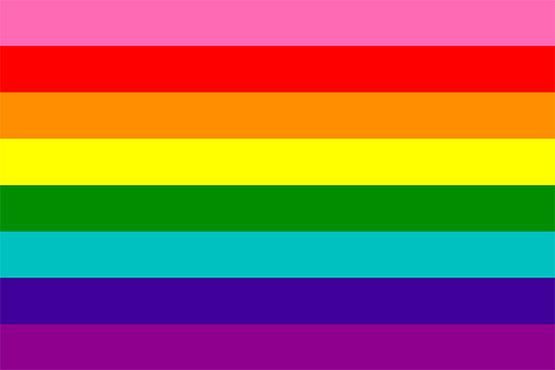 Gilbert Baker Pride Flag
Gilbert Baker Pride Flag
Gilbert Baker was challenged by Harvey Milk to come up with a symbol of pride for the gay community in 1977. He created the original Pride flag which was inspired by Judy Garland's Over the Rainbow. These colors flew at the San Francisco Gay Freedom Day Parade on June 25, 1978. Some dispute that Baker was the sole creator, but the symbolism still remains.
Each color celebrates an aspect of queer Pride:
Hot pink = Sex
Red = Life
Orange = Healing
Yellow = Sunlight
Green = Nature
Turquoise = Magic/Art
Indigo = Serenity
Violet = Spirit
1978-1999 Pride Flag 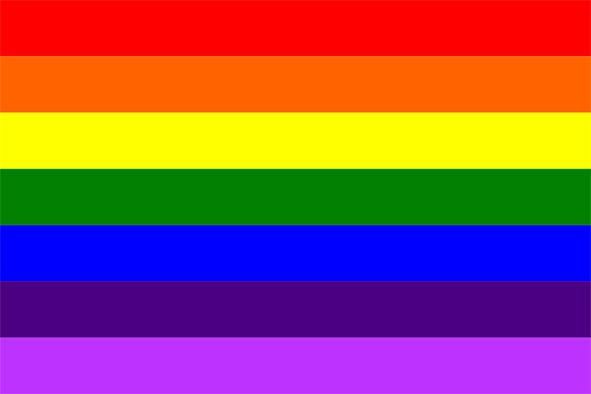
After the assassination of Harvey Milk, many wanted the Pride flag he commissioned to commemorate his accomplishments for the community and their personal support. The demand was greater than the available fabric, so the Paramount Flag Company began selling this version of the flag, as did Gilbert Baker, who had trouble getting hot pink fabric.
Traditional Gay Pride Flag
Probably the most familiar flag, in 1979, the community landed on this six color version which was hung from lamposts in San Francisco. There had been numerous complications over having an odd number of colors so it led to turquoise being dropped as a color. You can read more about the modern flag in this article written by the Advocate.
The website, Gizmodo, also offers a report about the complications in the pride flag creation. How the Pride flag lost its pink and turquoise stripes
Philadelphia People of Color-Inclusive Flag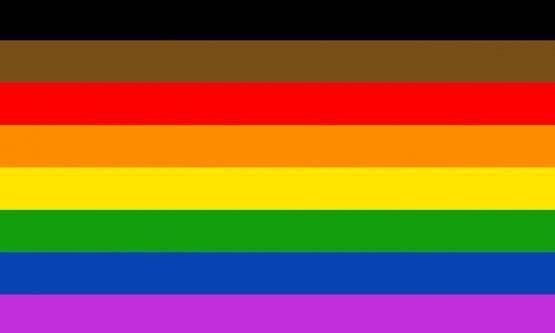
Noting that queer people of color are often not fully included in the LGBT community, the city of Philadelphia added two colors — black and brown — to the Pride flag in their honor. The city had previously faced accusations of racial discrimination in its gay bars, which led 11 queer nightlife venues to take antiracism training. Many white men were outraged by the flag, claiming that rainbow includes all skin colors, but with a star like Lena Waithe donning it at the Met Gala, it seems the design is here to stay.
QPOC Flag
The original creator of this flag is unknown but it represents solidarity with the Black Lives Matter movement and the inters ection of Queer and Black communities to the movements. For example Marsha P. Johnson, the Black drag queen who may have thrown the first brick at the Stonewall Inn riots. The raised fist symbolizes unity and support as well as defiance and resistance. The different colors on the fist represent diversity.
ection of Queer and Black communities to the movements. For example Marsha P. Johnson, the Black drag queen who may have thrown the first brick at the Stonewall Inn riots. The raised fist symbolizes unity and support as well as defiance and resistance. The different colors on the fist represent diversity.
Bisexual Flag
Created in 1998 by Michael Page, this flag spotlights bisexual people. Blue and Pink were overlapped to create lavender to symbolize th e attraction to both sexes.
e attraction to both sexes.
Progress Pride Flag
Created by queer, nonbinary artist, Daniel Quasar (xe/they). Quasar wanted to put more emphasis on the design to deepen its meaning. The Brown and Black stripes represent people of color and those people who have died from AIDS. The white, pink, blue are the colors from the transgender flag. This flag was flying over the Massachusetts State House in Boston to honor the 2020 In Person Pride Parade that was cancelled.
Pansexual Flag
This flag, for example, represents pansexuality's interest in all genders: Pink for women, blue for men, yellow for "nonbinary and gender-nonconforming people." It was created in 2010 to distinguish pansexuality from bisexuality.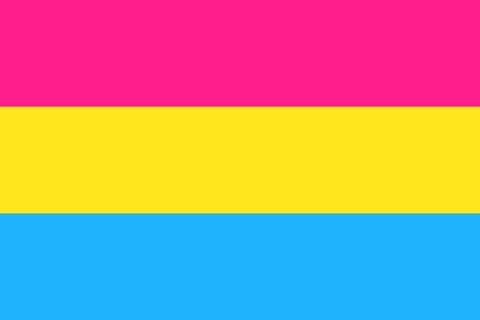
Asexual Flag
The Asexual Visibility and Education Network wanted to have a symbol that belongs to "all of us." Inspired by their logo, in 201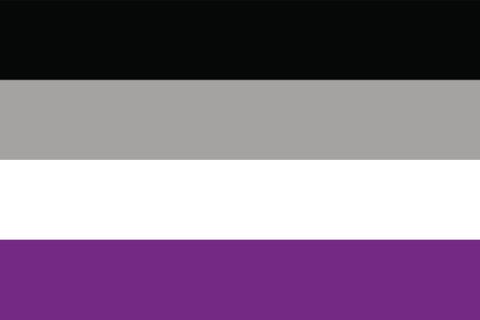 0, this flag was created. Black represents asexuality, gray represents graysexuals (between sexual and asexual) and it also represents demisexual which is sexual attraction that follows emotional connection and finally, purple represents community.
0, this flag was created. Black represents asexuality, gray represents graysexuals (between sexual and asexual) and it also represents demisexual which is sexual attraction that follows emotional connection and finally, purple represents community.
Demisexual Flag
The demisexual flag exists on the asexual spectrum (hence the similar colors in a different configuration), but also has its own 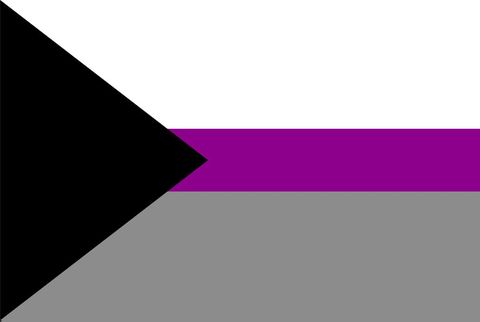 separate flag.
separate flag.
The term was coined in 2006 on The Asexual Visibility & Education Network (AVEN) by user “sonofzeal” but it's not known who designed the original flag. It is presumed that it was created after the creation of the asexual flag in 2010. Black represents a lack of sexual attraction, purple represents the ace-spec community. Grey represents greysexual which includes demisexuality. White represents sexual attraction on this flag.
What does it mean to be demisexual?
Demisexual is a sexual orientation on the asexual spectrum defined as someone who does not experience sexual attraction until they have formed a deep emotional connection with someone. The connection can be romantic, platonic, or some other form of connection. What counts as a "close connection" can vary between demisexuals. Forming an emotional bond with someone does not mean that one is automatically attracted to said person, as it just means there's now a possibility for one to feel attraction.
Source: LGBTA Wiki
Source: Marie Claire: 30 different pride flags and their meanings
Lesbian Pride Flag
The Lesbian Pride Flag, featuring seven different shades of pink, orange, white and red, is flown as the official lesbian flag . In some cases an older variant is flown, which features more red and pink in the stripes instead of orange. Sometimes, this red / pink variant features the addition of a lipstick mark in one corner and is flown to celebrate the subculture of Lipstick Lesbian, members of which stick to a ‘feminine’ image rather than taking a ‘butch’ one. This design became popular around 2018 and is one of several other designs.
. In some cases an older variant is flown, which features more red and pink in the stripes instead of orange. Sometimes, this red / pink variant features the addition of a lipstick mark in one corner and is flown to celebrate the subculture of Lipstick Lesbian, members of which stick to a ‘feminine’ image rather than taking a ‘butch’ one. This design became popular around 2018 and is one of several other designs.
Source: TriPride- Pride Flags
In 2018, this new version added more colors to celebrate (from top to bottom) gender non-conformity, independence, community, unique relationships to womanhood, serenity and peace, love and sex, and femininity. The debate about representation goes on.
Source: Marie Claire: 30 Different Pride Flags and What each Represents
Pansexual Pride Flag
The pansexual pride flag was designed as a symbol for the pansexual community to use. The pansexual pride flag has been found on various internet sites since mid-2010. It is used to indicate that pansexuals have romantic attractions and relationships with people of different genders and sexualities.
internet sites since mid-2010. It is used to indicate that pansexuals have romantic attractions and relationships with people of different genders and sexualities.
Source: TriPride: Pride Flags
Colors meaning: Pink for women, blue for men, yellow for "nonbinary and gender-nonconforming people."
Source: Marie Claire: 30 Different Pride Flags and What they represent
What does pansexual mean?
Pansexual (often shortened to pan) is the attraction to people regardless of gender. As a result, they are attracted to all genders. Pansexual people may be described as being "gender blind" showing that gender is not a factor in their attraction to a person.
Source: LGBTA Wiki
 Transgender Flag
Transgender Flag
This flag was created by Monica Helms, an American transwoman in 1999. It was first shown at a pride parade given in Phoenix Arizona in 2000. According to Helms the the stripes at the top and bottom are light blue which is a traditional color for baby boys. The pink stripes are the traditional color for baby girls. The white stripe in the center symbolizes those who are intersex, transitioning or consider themselves as having a neutral or undefined gender. The pattern was made in such a way that no matter how it is flown, it will always be correct, thus symbolizing us finding correctness within our own lives.
Source: TriPride - Pride Flags
What does Transgender mean?
Transgender (often shortened to trans) is a term referring to people who do not identify as the gender assigned to them at birth. It commonly refers to men who were assigned female at birth (trans men), and women who were assigned male at birth (trans women); these examples are known as binary transgender people. All non-binary people are also inherently included under the term transgender, because their gender is not what was assigned to them at birth; However, some non-binary people choose not to use "trans" as a label.
Transgender is not a gender identity on its own, rather it is a gender modality; It shows that there is a difference between one's assigned gender at birth and one's actual gender.
The opposite of transgender is cisgender.
Source: LGBTA Wiki: Transgender
Polysexual Flag
The colors and design of the polysexual flag are based on the pansexual and bisexual pride flags, borrowing the pink and blue, and replacing the yellow and purple stripes with a green one. Polysexuality is a self-identifying term that is somewhat amorphous, as there is a wide variety of different people who use the term to describe themselves. Polysexual identity is related to gender identity and is used by some people who identify outside the binarist gender spectrum. People who refer to themselves as polysexual may be attracted to third gender people, two-spirit people, genderqueer people, or people who are intersex. However, polysexuality does not have to be the exclusive attraction towards non-binary genders or sexes, though it can be. People who identify as polysexual may still be attracted to one or both binary genders or sexes.
there is a wide variety of different people who use the term to describe themselves. Polysexual identity is related to gender identity and is used by some people who identify outside the binarist gender spectrum. People who refer to themselves as polysexual may be attracted to third gender people, two-spirit people, genderqueer people, or people who are intersex. However, polysexuality does not have to be the exclusive attraction towards non-binary genders or sexes, though it can be. People who identify as polysexual may still be attracted to one or both binary genders or sexes.